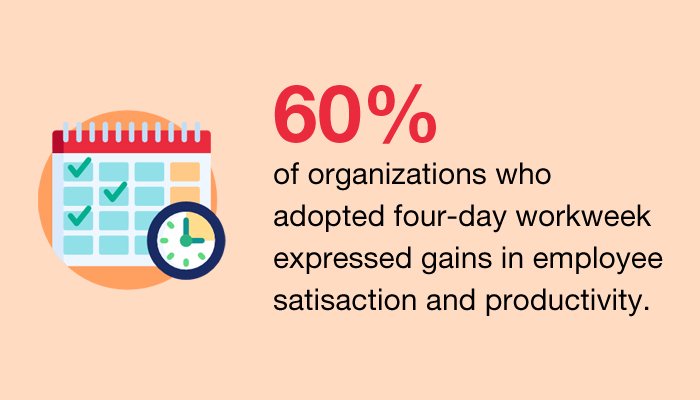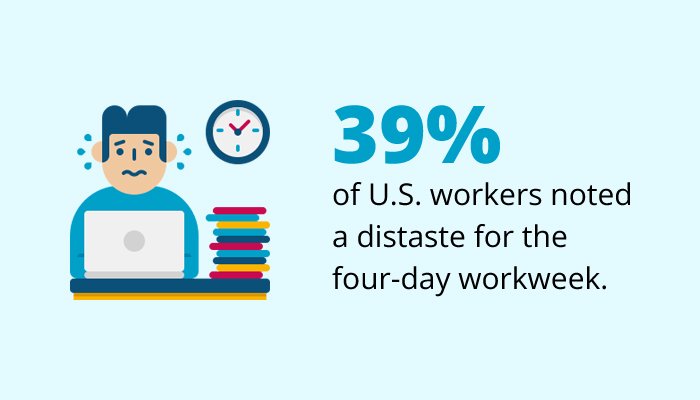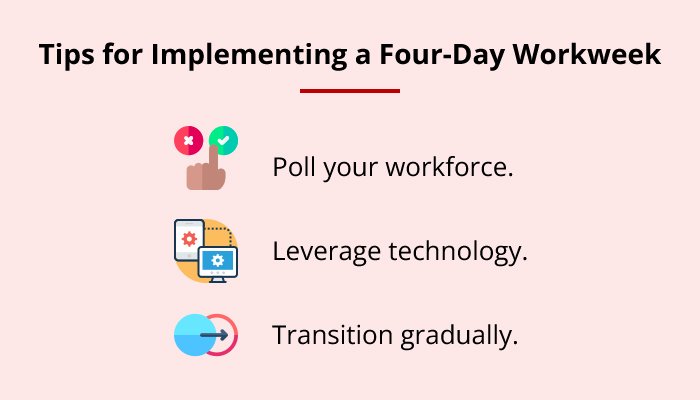The Benefits of a Four-Day Workweek

The four-day workweek isn’t a new idea. In fact, it’s been tested in Japan, New Zealand, Iceland, Spain, and the state of Utah with overwhelming success.
But since COVID-19, it’s been gaining more momentum.
The pandemic forced many companies to rethink what work looks like (e.g. remote work and hybrid schedules), and switching from a five-day to a four-day workweek was the logical next step.
Why? Well, workers are becoming less happy at work. A 2021 Harvard Business Review survey of 1,500 employees revealed the following:
- 89% of respondents said their work life was getting worse.
- 85% said their well-being had declined.
- 56% said their job demands had increased.
These statistics aren’t encouraging. But if you adopt a four-day workweek, you can improve many of these workplace ills.
In this article, we’ll explain what a four-day workweek looks like and the benefits and challenges that come with it.
What Does a Four-Day Workweek Look Like?
A four-day workweek means condensing the traditional five-day workweek into four days. Ideally, employers do this without any decrease in output, productivity, pay, or benefits. You simply fit 40 hours of work into 32 hours.
Many companies choose to have employees work Monday through Thursday and then take Friday through Sunday off. Others let employees choose their own workdays so long as they add up to four per week. Either way, giving employees three days off work has many benefits.
The Benefits of a Four-Day Workweek

The benefits of the four-day work week include the following:
1. Better work-life balance
The four-day workweek offers a better work-life balance. For example, employees can spend more time with their family and friends and use the three-day weekends to go on more outings and vacations.
It also gives employees more time for their personal development, education, hobbies, home projects, and even doctor appointments. Having more time to do these things will keep workers happier at home and work.
2. Improved employee health
When working only four days a week, employees tend to stay healthier. They get more time to take care of their physical, mental, and emotional health, which means fewer sick days, less burnout, and higher worker satisfaction and employee retention.
If you’re serious about improving workers’ health, you need to encourage self-care by giving employees enough time off work.
Less work can be helpful in preventing employee burnout.
3. Lower operating costs
The four-day workweek also helps lower your operating expenses. With workers in the office for one less day, you’ll have fewer costs from utilities (gas, electricity, A/C, water), supplies, commutes, and more.
By reducing your overhead costs this way, you can actually boost profits!
4. Increased productivity
The real question on the four-day workweek is about productivity. Do workers still get as much done in four days as they do in five? The answer is yes.
This is because most salaried employees only get about 3 hours of real work done each day. The law of diminishing marginal returns says that people’s productivity drops after that.
So if you shorten the workweek from five to four days, the relative output of your employees will increase. So on top of having happier employees, you could actually gain higher profits. It’s a win-win.
5. Reduced environmental impact
Lastly, by coming into the office one less day, you reduce your carbon footprint. You’ll use less natural gas and electricity to operate the office and you’ll help decrease the amount of gas that employees use to commute to work.
Every company has a responsibility to do its part in fighting against climate change and adopting the four-day workweek is a great way to do it.
The Challenges of a Four-Day Workweek

That said, switching to a four-day workweek still has some challenges:
1. Less time to get work done
For some workers, the prospect of having less time to get work done can be stressful. Not everyone responds well to the extra pressure. So make sure you’re sensitive to employees’ needs.
If you’re not careful, workers might end up compensating for having one less workday by staying in the office longer, squeezing their past 40-hour workweek into four 10-hour days. But this defeats the point.
2. Less availability for customers
Cutting out a workday could mean you’ll be less available for customers. If clients expect you to answer emails, messages, and calls Monday through Friday, this might hurt your business. So be sure to communicate your service hours clearly.
Tips for Implementing a Four-Day Workweek

If you’ve weighed the pros and cons and decided to implement the four-day workweek, here are some ways to make the transition smoother:
- Poll your workforce. Before switching to a four-day workweek, make sure it’s something your employees want. Send around a poll and try to do what’s best for the majority.
- Leverage technology. Since workers will interact in person less, it helps to invest in the best video conferencing software and project management tools. That way, everyone can stay on the same page.
- Transition gradually. The transition from a five-day week to a four-day workweek can be rough. But if you plan in advance and give everyone plenty of notice, the transition will go more smoothly.
The four-day workweek isn’t for every company, but many can benefit from the switch. You won’t know until you give it a try.
- Mastering Internal Mobility: A Comprehensive Guide to Success - August 10, 2023
- Effective Recruiting Strategies in a Competitive Sales Labor Market - July 27, 2023
- 6 Essential Factors to Attract Top Talent - July 19, 2023
